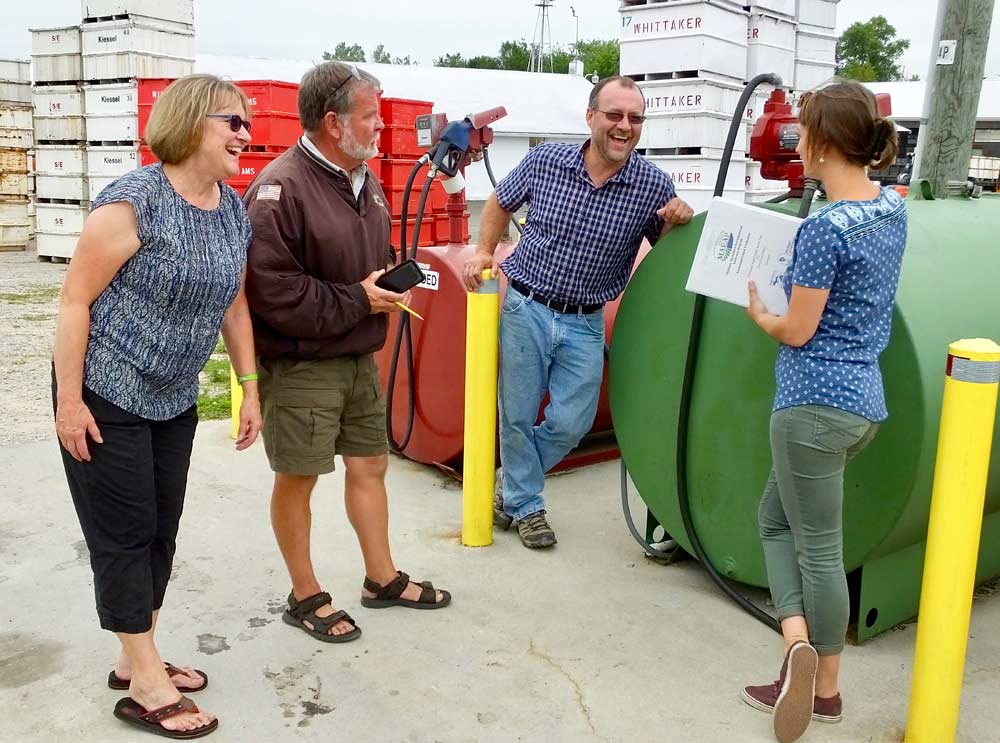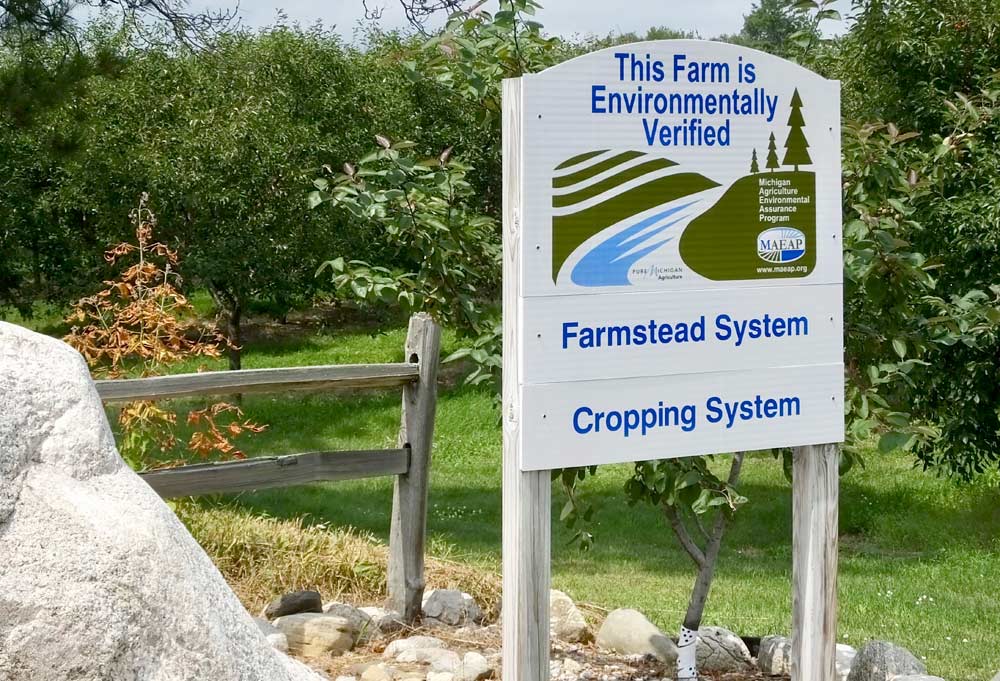
Orchard owners Nita and Jeff Send (left), MAEAP verifier Dan Busby and MAEAP technician Lizzy Freed meet at the farm’s fuel site. Here, the Sends have added a containment pad and updated fuel tanks, which will reduce the risk of fuel leaks and the potential for seepage into the groundwater. (By Leslie Mertz)
Northwest Michigan cherry grower Jeff Send admits he was a “hard egg to crack” when a state technician first approached him about going through the process to get his nearly 1,000-acre Cherry Lane Farms environmentally verified.
“I didn’t want a damn thing to do with it, because I didn’t want anybody on my property. I didn’t want anyone seeing what we were doing or what was behind that (fuel) tank or in that chemical building. I didn’t want anybody seeing any of this,” he recalled.
His wife, Nita, who co-owns the farm with him, said he needed a good deal of convincing before finally relenting.
Technician Dan Busby with the Michigan Agriculture Environmental Assurance Program, also known as MAEAP, sold him on the idea by emphasizing that it was voluntary and confidential.
“It wasn’t the government coming to look for problems and issue a fine or penalty,” she said. “This is proactive. It is trying to prevent problems, and it just makes sense.”
She looked out toward a blue and green sign posted at the entrance to the orchard and said, “We’re proud of our sign.” In big letters, it reads, “This Farm is Environmentally Verified.”
What is MAEAP?

Jeff and Nita Send are proud of this sign that stands in front of their orchard, Cherry Lane Farms, in northwestern Lower Michigan. It signifies that the farm has voluntarily met a set of standards set by the Michigan Agriculture Environmental Assurance Program (MAEAP) in its cropping and farmstead systems, which together focus on such farming aspects as irrigation and water use, soil conservation, safe handling of fuels and proper storage of chemicals. (By Leslie Mertz)
MAEAP (pronounced “meep”) ensures that Michigan farmers are engaging in cost-effective pollution prevention practices and working to comply with state and federal environmental regulations.
In other words, according to MAEAP director Joe Kelpinski, “It’s an environmental check that lets a farm know where they’re at and how to find solutions to do it better. We essentially act as their environmental consultants.” Funding for MAEAP primarily consists of fees collected from the sale of pesticides and fertilizers.
The process to become verified has three phases, the first being an overview of the program. Then, a MAEAP technician visits the site and gathers information, using a set of tools to assess various practices, such as how pesticides, herbicides and petroleum products are stored, or how waste is managed. The technician then sits down with the farmer and comes up with an action plan.
“It’s basically a to-do list that the growers can complete at their own speed, because we can’t expect them to put down money for a long list of things that aren’t their highest priorities. That’s why we don’t have any deadlines,” said technician Lizzy Freed, one of three-dozen technicians housed at local conservation district offices.
At Cherry Lane Farms, which is also a receiving station for other cherry growers, the to-do list included a number of small items and a few larger ones: fuel tanks and containment pads for the chemical building to prevent spills from draining into the ground and groundwater. The couple opted to take the chemical building upgrades a step further and included an insulated room to safely overwinter chemicals.
“In going through the list, we would constantly come across things where, gee, we had never thought about that,” Nita Send said. “So, it’s not like farmers are intentionally trying to do the wrong thing; it’s just that it hasn’t been specifically pointed out and there hasn’t been anybody that you trusted to ask.”
Once the farm’s to-do list is accomplished, the grower calls MAEAP for the final verification. A verifier then arrives to make sure everything is up to snuff and gives the final stamp of approval.
Why do it?
Depending on the improvements to be made, environmental verification can require a considerable capital outlay. Sometimes, grant funding is available to offset costs, but often the grower foots the bill.
“It’s really a tough time to try to pull some of this off, because the farmers are not making that much money and there are costs involved, but I’ve always wanted to clean the place up, and MAEAP just helped me do it,” Jeff Send said.
In some cases, farmers are receiving discounts on their insurance. The Farm Bureau offers a reduction in the pollution liability portion of its coverage, which ends up being a fair amount, though it’s the only insurer on record to do so, said Busby, who is now a MAEAP verifier. “Other growers have confronted their insurance carriers and have been able to reduce their rates a bit,” he said. “Let’s face it: Spill cleanups are expensive, and the risk of that happening is quite reduced by going through the MAEAP process.”
Verified farms also receive some additional protections. About a decade after the program began, the state Legislature in 2011 officially recognized that MAEAP-verified farmers are meeting all best management practices on their farms and guaranteed them against penalties from accidental or act-of-God discharges.
As of late August 2017, nearly 3,000 farms have received MAEAP verifications. Although Kelpinski doesn’t have a breakdown on the number of orchards and vineyards in that total, he estimates they make up 5 to 10 percent of the total.
From the standpoint of the agriculture industry, MAEAP verifications are an excellent way to showcase farmers as environmental stewards, Busby said. For instance, the Cherry Marketing Institute encourages verification, which it then publicizes as a good indicator of the industry’s concern for the environment.
This not only gets out the word to consumers, but also appeases commercial buyers who want to make sure fruits and vegetables are properly grown. Many growers use their MAEAP verification in individual marketing efforts.
Additionally, growers are finding that the MAEAP process helps to prepare them for the U.S. Department of Agriculture’s Good Agricultural Practices (GAP) and Good Handling Practices (GHP) audits that are designed to minimize food safety hazards.
For the Sends, the MAEAP process just seemed like the right thing to do. “Jeff’s grandpa originally bought this farm 99 years ago, our daughter runs the receiving station, her husband works on the farm, and their kids, who are only 11 and 4, also help out. We have a responsibility to all five generations to take care of the land and water,” Nita Send said.
“And those of us who have been verified are always encouraging other growers to get verified,” she said. “You really do want one of these signs on your farm.” •
– by Leslie Mertz






Leave A Comment